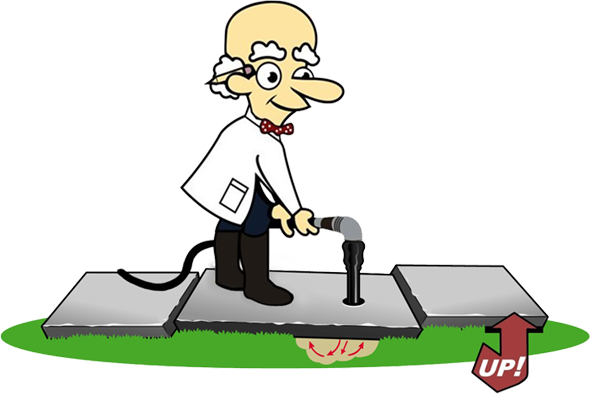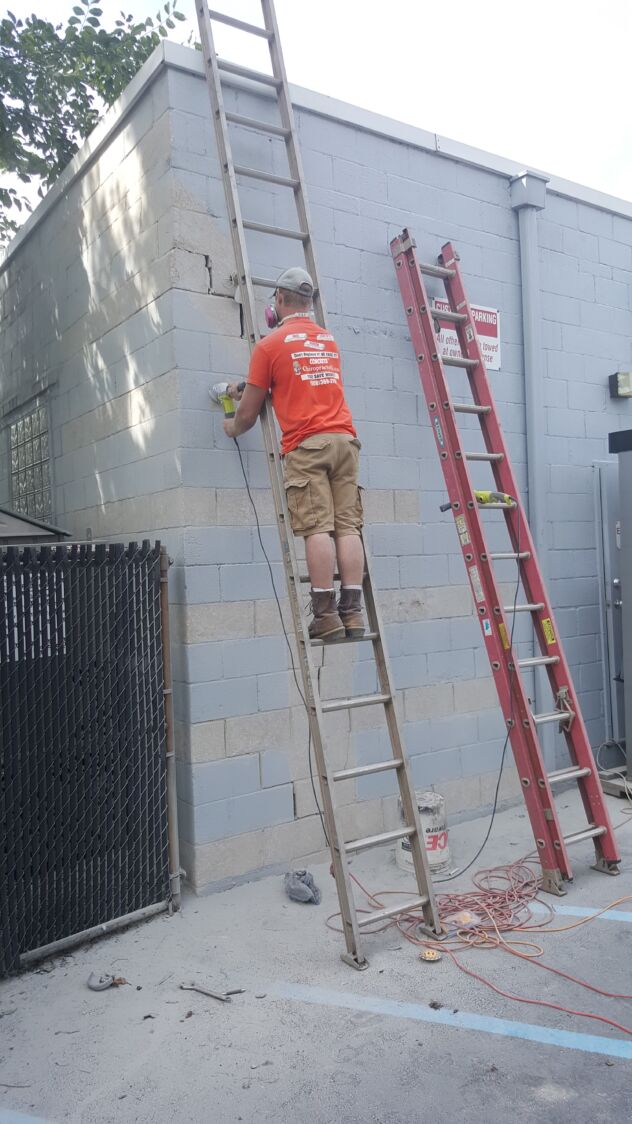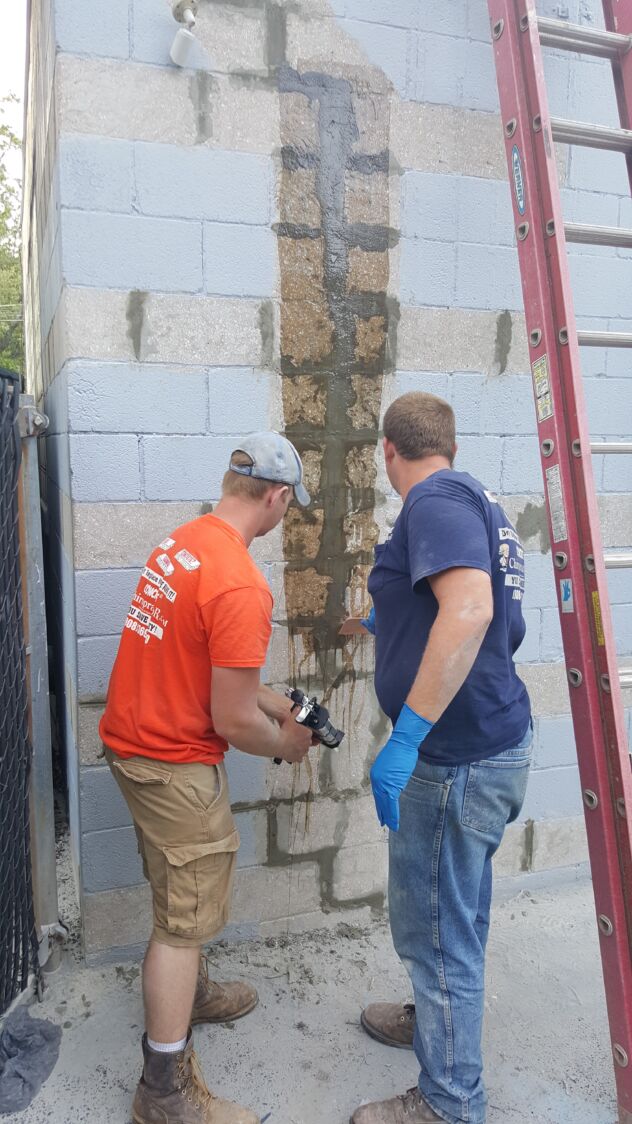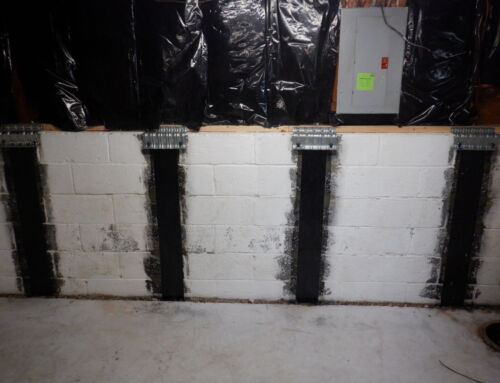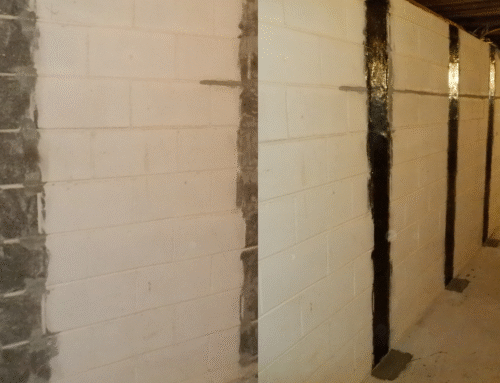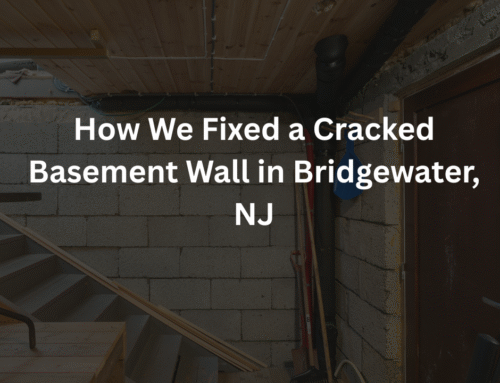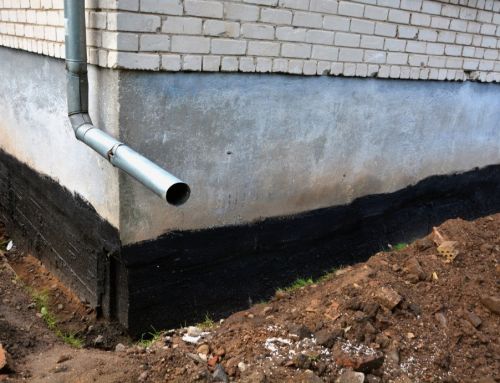IN THIS ARTICLE
Discover how we repaired a cracked Basement Wall with Carbon Fiber Straps in Holmdel, NJ.
Cracks in concrete block walls are never a good sign, especially when they start to spread or form stair-step patterns. They can mean that pressure from the soil is pushing against the wall, or that moisture has been building up behind it for a while.
At Concrete Chiropractor, we recently worked on a project for B & G Gulf (also known as B & G Gas Station) in Holmdel, New Jersey, where the side wall of their building showed visible cracking. Using our carbon fiber wall strap system, we were able to stabilize the structure without any excavation or heavy equipment. Here’s how we did it.
What We Noticed from the Photos
We asked the client to send us clear photos of the affected wall. This is how we begin every job. By examining the pictures, we can usually determine the type of damage, the level of movement, and the best method of repair.
The photos from B & G Gulf showed a stair-step crack running diagonally across several rows of concrete blocks. This pattern often forms when pressure from wet soil or frost expansion pushes against the wall. We could also see some areas where previous repairs had failed, and minor displacement in the blocks, but no signs of severe bulging or major structural collapse.
From this evaluation, we confirmed that the wall was a good candidate for carbon fiber reinforcement. This method is designed for cracks or inward wall movement up to about 2 inches, which matches what we observed in the photos.
How the Client Found Us
The owner found us through a Google search for “cracked concrete wall repair in New Jersey” and other related searches such as “foundation wall repair Holmdel” and “carbon fiber wall strap installation NJ.”
After visiting our website, they called for a free consultation. We requested several photos of the cracked wall, including both wide shots and close-ups. Once we received them, we reviewed the images, evaluated the wall condition, and provided a free estimate based on the visible evidence.
This approach saves time for both sides. Homeowners and business owners can get a professional assessment without scheduling a site visit, and we can provide an accurate estimate quickly.
Our Repair Approach: Carbon Fiber Wall Strap System
When a concrete or block wall starts to crack or bow, it usually happens because of hydrostatic pressure in the soil. As water builds up around the foundation, it pushes inward. Over time, the wall can no longer resist the force, and cracks begin to form.
Instead of using traditional steel beams or large excavation methods, we use carbon fiber straps to stabilize and reinforce the wall. Carbon fiber is an advanced material known for being stronger than steel in tension and highly resistant to corrosion. Once bonded to the wall with structural epoxy, it prevents any further inward movement and adds permanent strength.
This system is non-invasive. It does not require digging or removing sections of the wall, and the straps are flat enough to be painted over for a clean finish.
Step-by-Step: How We Repair Cracked Block Walls
Step 1: Surface Preparation
We start by cleaning the wall and grinding the surface where each carbon fiber strap will be installed. Any loose material, paint, or efflorescence is removed to ensure a strong bond. The surface must be solid and dry before epoxy application.
Step 2: Crack Sealing
Visible cracks are filled with a high-strength hydraulic cement. This step prevents moisture from entering and provides a smooth surface for the strap to adhere to.
Step 3: Epoxy Application
A layer of structural-grade epoxy is applied to the prepared area. This acts as the bonding agent that holds the carbon fiber strap securely to the wall.
Step 4: Installing the Carbon Fiber Straps
The carbon fiber straps are applied vertically along the wall from the base to the sill plate. They are pressed into the epoxy and aligned carefully to maintain even tension. The spacing between straps depends on the amount of wall stress, but it typically ranges from three to four feet.
Step 5: Top Anchoring
Each strap is mechanically secured to the top of the wall with a bracket attached to the sill plate. This prevents future inward movement and locks the wall in position.
Step 6: Final Epoxy Coat and Finish
A final coat of epoxy is applied over the strap to seal and protect it. Once cured, the surface can be painted, leaving a smooth, professional finish that blends with the rest of the wall.
Why We Chose Carbon Fiber for This Project
The B & G Gulf wall had visible cracking but no extreme displacement. That made it ideal for carbon fiber reinforcement. This system provides long-term stability without altering the appearance of the building or interrupting business operations.
Other methods, such as steel I-beams or wall anchors, are effective for more severe movement, but they require more labor and sometimes excavation. For this project, carbon fiber offered a strong, clean, and efficient solution.
The finished result was a stabilized wall that looked neat and strong. The straps now distribute pressure evenly across the wall and stop further bowing or cracking.
Challenges and Considerations
Because the wall is part of a gas station structure, it is constantly exposed to weather conditions. Temperature swings and moisture can cause small amounts of wall expansion and contraction. To address this, we used a flexible epoxy formulation that maintains adhesion even with minor movement.
We also advised the owner to monitor surface water and check that gutters and grading direct runoff away from the wall. Controlling moisture is one of the best ways to prevent similar issues from developing again.
Results and Final Outcome
Once the installation was complete, the wall regained its structural integrity. The cracks were sealed, the surface was uniform, and the wall was ready for painting. The business remained open throughout the process since the repair required no excavation and produced no disruption.
The client appreciated how easy it was to get the entire job started through photos and email communication. The process was fast, accurate, and permanent.
Tips for Property Owners in New Jersey
If you see cracks forming in your basement or block walls, take a few simple steps:
- Take clear photos from several angles, including close-ups and full wall views.
- Look for patterns such as stair-step or horizontal cracks, which often indicate soil pressure.
- Check the extent of movement. If the wall bows inward less than two inches, carbon fiber reinforcement is likely suitable.
- Inspect your drainage system to make sure water is not pooling near the foundation.
- Contact us early. Carbon fiber repairs are most effective when the damage is still moderate.
Our photo-based evaluation makes it easy to get a free professional opinion before the problem worsens.
Conclusion
Cracked or bowed block walls can become serious structural issues if ignored. Fortunately, modern technology offers a reliable and permanent solution.
At Concrete Chiropractor, we use carbon fiber wall strap systems to restore and reinforce concrete walls safely and effectively. Our process is quick, clean, and based on over 25 years of experience repairing concrete walls and floors across New Jersey and Eastern Pennsylvania.
If you see signs of wall movement or cracking in your property, don’t wait until the problem grows. Send us photos today for a free evaluation and estimate. We’ll review them, determine the best solution, and help you restore your wall the right way.
- How We Repaired a Cracked Basement Wall in Raritan, NJ - October 26, 2025
- How We Repaired a Bowing Concrete Block Wall in Hillsborough, NJ - October 25, 2025
- How We Fix a Cracked Concrete Block Wall at B & G Gulf in Holmdel, NJ - October 23, 2025

